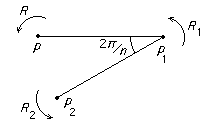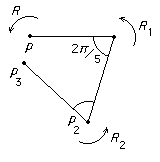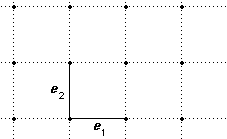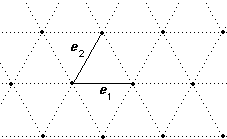We will give the proof for R2. The proof for R3 is similar. It is harder for higher dimensions!
Let L be the lattice and let M be the set of all centres of rotations in Sd(L). This will include L since rotation by π about any lattice point is in Sd, but will in fact be bigger. It will, however, still be discrete.
 Now let p ∈ M be the centre of a rotation R by 2π/n.
Now let p ∈ M be the centre of a rotation R by 2π/n.Let p1 ∈ M be a closest point of M which is the centre of a rotation R1 by 2π/n.
Let p2 = R1(p).
Now if T is any transformation mapping a point x to T(x) then conjugating a rotation about x by T gives a rotation (by the same angle) about T(x).
Thus conjugating R by R1 gives a rotation R2 by 2π/n about the point p2 and the diagram shows that if n > 6 the point p2 would be closer to p than p1 contradicting the definition of p1 .
 A similar proof using this diagram:
A similar proof using this diagram:with p3 = R2(p1), rules out the possibility that n = 5.

Remark

